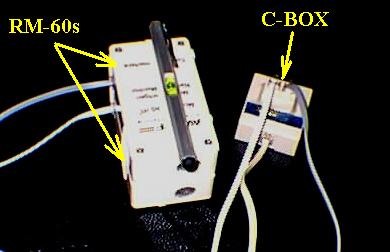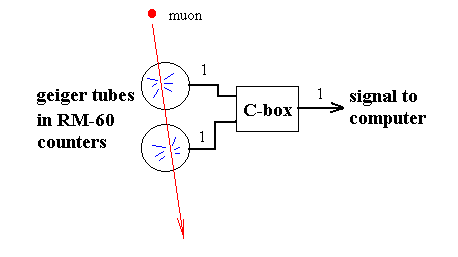 |
QuarkNetter Reports: The Geiger Detector |
 |

Photo courtesy of James A. Petrait
The Geiger detector commercially available from Aware Electronics shows promise for two reasons:The main business at Aware Electronics is Geiger counters. Their RM-60 is a small Geiger counter which connects to a PC for readout. Just about any Wintel machine will do including that old DOS-based 386 you were going to toss. Someone at Aware Electronics got the simple idea that a coincidence circuit (C-box) connected to two RM-60s could be used to detect cosmic rays.
- The main components come assembled, so construction is just a matter of snapping a few cables into place.
- The total cost is less than $400 (excluding PC for readout).
Here's how it works. A cosmic ray muon passes through a Geiger tube in one counter causing a signal to be sent to the C-box. If that same muon passes through the Geiger tube in the other counter, the C-box will get a second signal. The C-box will send a signal to the computer only if it gets both coincident signals in a very short time period, in other words only if a muon passes through both detectors. The computer will record the "hit."
Background radiation is elminated as most background will hit only one counter or the other. On the other hand, cosmic ray muons will hit both counters most often if the counters are stacked vertically.
For the cost of the two RM-60 units (currently $149.50 each) and the C-box ($85.00), Aware Electronics provides all the hookup cables, software and instructions. It is a great way to start in the cosmic ray business.
There are drawbacks.
- The counting rate is very slow. The small Geiger counters have very little active area to pick up muons. To get a statistically significant count, you might have to wait an hour or more.
- As long as you stick with the available C-box, you can only do muon counts. Muon lifetime experiments are just not possible with this device in its present form.
- You do have to have that computer. If you can't manage to get hold of a laptop, that will limit your portability. On the other hand, the two counters and the C-box take up very little space, so if you can bag even an old laptop, you are on the move.
- This detector is a black box. Students cannot "play with" it to figure out how it works.
RATINGS
|
RESOURCES AND CONTACTSScientific American article explains how to build a similar detector from scratch: Counting Particles from Space by Shawn Carlson To order parts: Aware Electronics Corp. P.O. Box 4299, Wilmington, DE 19807 USA |
Return to Main Page
